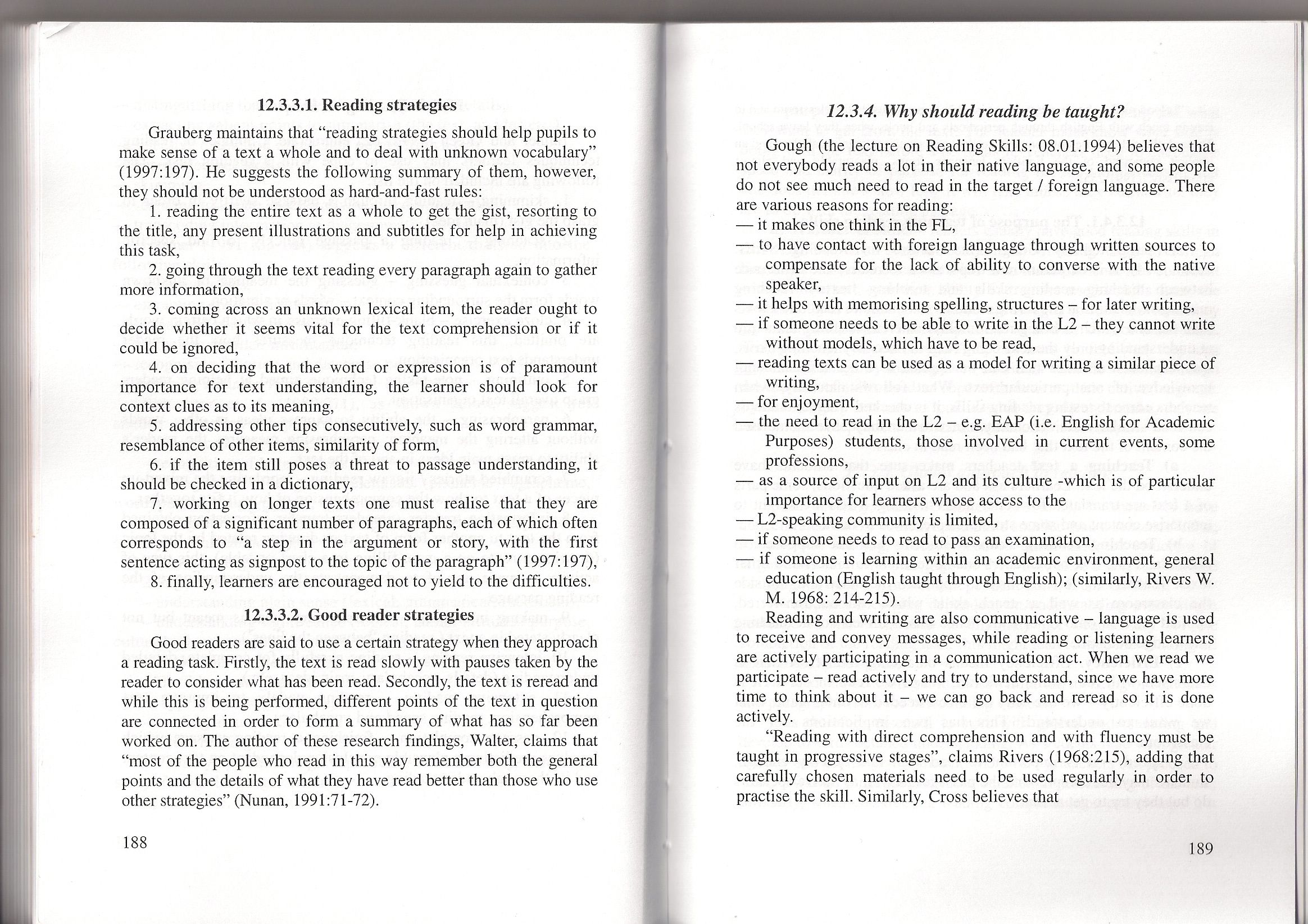26953 skanowanie0094 (2)

12.3.3.1. Reading strategies
Grauberg maintains that “reading strategies should help pupils to make sense of a text a whole and to deal with unknown vocabulary” (1997:197). He suggests the foliowing summary of them, howeyer, they should not be understood as hard-and-fast rules:
1. reading the entire text as a whole to get the gist, resorting to the title, any present illustrations and subtitles for help in achieving this task,
2. going through the text reading every paragraph again to gather morę information,
3. Corning across an unknown lexical item, the reader ought to decide whether it seems vital for the text comprehension or if it could be ignored,
4. on deciding that the word or expression is of paramount importance for text understanding, the learner should look for context clues as to its meaning,
5. addressing other tips consecutively, such as word grammar, resemblance of other items, similarity of form,
6. if the item still poses a threat to passage understanding, it should be checked in a dictionary,
7. working on longer texts one must realise that they are composed of a significant number of paragraphs, each of which often corresponds to “a step in the argument or story, with the first sentence acting as signpost to the topie of the paragraph” (1997:197),
8. finally, leamers are encouraged not to yield to the difficulties.
12.3.3.2. Good reader strategies
Good readers are said to use a certain strategy when they approach a reading task. Firstly, the text is read slowly with pauses taken by the reader to consider what has been read. Secondly, the text is reread and while this is being performed, different points of the text in ąuestion are connected in order to form a summary of what has so far been worked on. The author of these research findings, Walter, claims that “most of the people who read in this way remember both the generał points and the details of what they have read better than those who use other strategies” (Nunan, 1991:71-72),
Gough (the lecture on Reading Skills: 08.01.1994) believes that not everybody reads a lot in their native language, and some people do not see much need to read in the target / foreign language. There are various reasons for reading: it makes one think in the FL,
— to have contact with foreign language through written sources to
compensate for the lack of ability to converse with the native speaker,
—- it helps with memorising spelling, structures — for later writing,
— if someone needs to be able to write in the L2 - they cannot write
without models, which have to be read,
-7- reading texts can be used as a model for writing a similar piece of writing, for enjoyment,
— the need to read in the L2 - e.g. EAP (i.e. English for Academic
Purposes) students, those involved in current events, some professions,
— as a source of input pn L2 and its culture -which is of particular
importance for leamers whose access to the
— L2-speaking community is limited,
— if someone needs to read to pass an examination,
— if someone is learning within an academic environment, generał
education (English taught through English); (similarly, Rivers W. M. 1968: 214-215).
Reading and writing are also communicative - language is used to receive and convey messages, while reading or listening leamers are actively participating in a communication act. When we read we participate - read actively and try to understand, sińce we have morę time to think about it .^we can go back and reread so it is done actively.
“Reading with direct comprehension and with fluency must be taught in progressive stages”, claims Rivers (1968:215), adding that carefully chosen materials need to be used regularly in order to practise the skill. Similarly, Cross believes that
189
Wyszukiwarka
Podobne podstrony:
26953 skanowanie0094 (2) 12.3.3.1. Reading strategies Grauberg maintains that “reading strategies sh
skanowanie0094 (2) 12.3.3.1. Reading strategies Grauberg maintains that “reading strategies should h
skanowanie0087 (2) 12.2.5.1. achievement strategies: a) strategies based on mother
63963 skanowanie0087 (2) 12.2.5.1. achievement strategies: a) strategies based on
00489 ~e67567f20b0f2c4c6ef9f248aae1ae 496 Parvey They also noted that the strategy should be easy t
skanowanie0053 (9) — it has to make sense, with the right choice of vocabulary,&nb
3 5 3 It aims at evoking a feeling that an interlocutor should not stick to his arguments because of
skanowanie0053 (9) — it has to make sense, with the right choice of vocabulary,&nb
[DPG] Page 8 IExaggerale his physique making his shoulders narrow relative to the size of his head s
[DPG] Page 8 (2) IExaggerate his physique making his shoulders narrow relative to the size of his he
00013 ?5c5a58795d3d3cd940c33cedaf2990 12 Woodall & Faltin We maintain, moreover, that before a
skanowanie0075 (3) 12.1.1.5. Real Iife vs. classroom listening In real life listening is easier beca
skanowanie0075 (3) 12.1.1.5. Real Iife vs. classroom listening In real life listening is easier beca
skanowanie0075 (3) 12.1.1.5. Real Iife vs. classroom listening In real life listening is easier beca
skanowanie0092 (2) 12.3.1.3, How do we read? Grellet (1981:4), suggests the main ways of reading to
skanowanie0103 (2) 12.4.3. Writing activities There are many different activities that students can
skanowanie0092 (2) 12.3.1.3, How do we read? Grellet (1981:4), suggests the main ways of reading to
więcej podobnych podstron